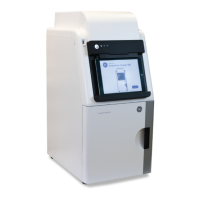
Do you have a question about the GE Amersham Imager 680 and is the answer not in the manual?
| Brand | GE |
|---|---|
| Model | Amersham Imager 680 |
| Category | Laboratory Equipment |
| Language | English |
Explains the manual's purpose, structure, and typographical conventions for clear instruction following.
Crucial guidance for users before installation, operation, or maintenance to ensure safety and prevent damage.
Details compliance with various international directives and standards, including CE marking and RoHS.
Provides essential warnings and cautions to prevent personal injury, equipment damage, and electrical hazards.
Illustrates and explains the meaning of various symbols and labels found on the instrument for identification and compliance.
Outlines steps for immediate shutdown and precautions during emergencies to ensure safety.
Provides instructions for the proper decommissioning, disposal, and recycling of the instrument and its components.
Lists hazardous substances present in the product as per Chinese standards and their environmental use period.
Presents a general overview of the Amersham Imager 680 as an imaging instrument for research applications.
Highlights the key features and capabilities, such as CCD camera, imaging modes, and software.
Provides a visual representation of the Amersham Imager 680, showing its physical setup with a tablet.
Details the different configurations, main hardware components, and their functions within the instrument.
Explains the software's workflow, components, and functions for image capture and analysis.
Lists and describes accessories that are included with the instrument or available for purchase.
Specifies the necessary environmental conditions and physical space for optimal instrument performance and safety.
Describes the initial installation process, emphasizing it's performed by authorized GE personnel.
Guides users through configuring various instrument-specific settings for optimal operation.
Information on setting up network connections for saving and accessing image files.
Step-by-step instructions for powering on the instrument and initiating the startup sequence.
Details the process of capturing images using chemiluminescence, colorimetric, and fluorescence methods.
Explains the workflow for performing detailed analysis of captured images using the software.
Instructions for saving, copying, and managing image files and organizing data.
Describes the correct procedure for shutting down the instrument when operations are complete.
Guide on system requirements and steps for installing and activating the analysis software.
Explains how to analyze captured images using the dedicated analysis software on a Windows PC.
Provides instructions for cleaning and maintaining the exterior and interior of the Amersham Imager 680.
Details recommended cleaning agents and methods for cleaning various instrument accessories.
Outlines routine checks to ensure the power supply, cords, and ventilation remain in good condition.
Addresses common instrument issues like unusual noise, odors, smoke, and LED blinking with corrective actions.
Provides solutions for issues such as incorrect exposure, focus, dirty components, and light leaks.
Offers troubleshooting steps for issues related to software response, screen display, and button functionality.
Lists the detailed technical specifications, including imaging, dimensions, power, and environmental requirements.
A checklist and declaration form for service personnel to confirm site safety and cleanliness.